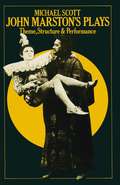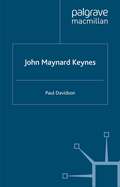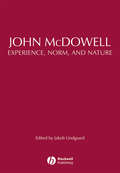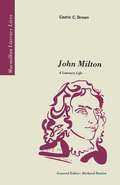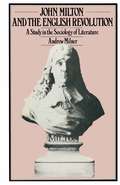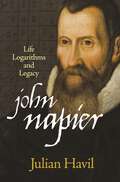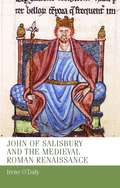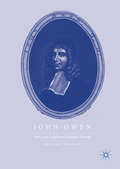- Table View
- List View
John Maitland of Thirlestane and the Foundation of the Stewart Despotism in Scotland
by M. Du Lee Jr.When John Maitland accepted the office of Secretary of State to James VI of Scotland in 1584, he accepted the challenge of three of the most extraordinary and persistent threats to the power of the crown that a king's principal advisor ever faced: the Scottish aristocracy, the Kirk, and Queen Elizabeth of England. By the time of his death eleven years later, Maitland had succeeded in helping his king break the power of the nobility, secure the support of both the Kirk and Elizabeth, and prepare the way for an absolutism of the Stewart kings of Scotland that was not finally destroyed until the Revolution of 1688. This investigation of how Maitland constructed his political coalition and how he held it together is a superb study in Renaissance politics.Originally published in 1959.The Princeton Legacy Library uses the latest print-on-demand technology to again make available previously out-of-print books from the distinguished backlist of Princeton University Press. These editions preserve the original texts of these important books while presenting them in durable paperback and hardcover editions. The goal of the Princeton Legacy Library is to vastly increase access to the rich scholarly heritage found in the thousands of books published by Princeton University Press since its founding in 1905.
John Marshall: The Man Who Made the Supreme Court
by Richard BrookhiserThe life of John Marshall, Founding Father and America's premier chief justice. In 1801, a genial and brilliant Revolutionary War veteran and politician became the fourth chief justice of the United States. He would hold the post for 34 years (still a record), expounding the Constitution he loved. Before he joined the Supreme Court, it was the weakling of the federal government, lacking in dignity and clout. After he died, it could never be ignored again. Through three decades of dramatic cases involving businessmen, scoundrels, Native Americans, and slaves, Marshall defended the federal government against unruly states, established the Supreme Court's right to rebuke Congress or the president, and unleashed the power of American commerce. For better and for worse, he made the Supreme Court a pillar of American life. In John Marshall, award-winning biographer Richard Brookhiser vividly chronicles America's greatest judge and the world he made.
John Marshall: The Chief Justice Who Saved the Nation
by Harlow Giles UngerA soul-stirring biography of John Marshall, the young republic's great chief justice, who led the Supreme Court to power and brought law and order to the nation
John Maynard Keynes (Great Thinkers in Economics)
by P. DavidsonThis book looks at the life of Keynes leading up to the writing of his seminal General Theory , examines the General Theory in detail, and explores how it differs from classical theory. The impact of Keynes's work on the economy postwar and up to the present day is also assessed.
John Maynard Keynes: A Study in the Psychology of Original Work
by P. MiniKeynes's personality was fixed by the clash between Moorean values - other-worldliness, idealism, pacifism - and Keynes's own nature which craved and attained worldly success, wealth and social influence and approbation. The result was an 'existential' outlook that caused him to become particularly sensitive to the human condition, to human suffering and to real concern. Accordingly, Keynes came to see the world through human, down-to-earth, social nd psychological categories, which were opposed to the 'devine' Platonism of classical economics. This book is thus opposed to the recent probability-based interpretations of Keynes's mature work.
John McDermott: It's not all Black & White
by John McDermott Simon AshberryWhen John McDermott received the annual PFA Merit Award, in recognition of his record-breaking career at Grimsby Town, he joined an elite group of footballers made up of the likes of Sir Bobby Charlton, Pelé and George Best. McDermott was added to the distinguished list of recipients in recognition of his record-breaking career at Grimsby Town. He played an incredible 754 games overall for the Mariners and is one of only seventeen players in the history of English football to play more than 600 Football League matches for the same. Now McDermott is lifting the lid for the first time on the career that made him one of the most respected defenders in the Football League for two decades and secured him legendary status among the fans at Blundell Park. He gives a humorous and revealing insight into what went on behind the scenes as the Mariners marched to back-to-back promotions to the second tier of English football and also muses on the pitfalls of staying loyal to a single club.
John McDowell: Experience, Norm, and Nature
by Jakob LindgaardJohn McDowell: Experience, Norm, and Nature combines original essays by leading contemporary philosophers with point by point responses by McDowell himself to explore the central themes of one of the most innovative philosophers of our day. Provides original and critical essays examining McDowell’s reading and appropriation of Sellars, Kant, and Hegel in his own philosophy Explores McDowell’s notions of perceptual experience and his proposed rethinking of our conception of nature in light of the challenges that reason and normativity introduce Includes an original essay by McDowell that includes significant developments of his conception of perceptual experience Offers thorough and penetrating responses by McDowell to his critics
John Milton: A Literary Life (Literary Lives)
by Cedric C. BrownFor the first time in an approachable, affordable volume this study treats the whole literary career of England's most distinguished protestant-republican poet and writer, considering the miscellaneous output in the light of contexts and political functions. It highlights self-presentational and persuasive characteristics, pays attention to the sense of vocation and also describes Milton's distinctive achievement in social genres. Milton's competitive humanist training is seen to accomodate uneasily to the specific demands of some public works. The book features unfamiliar texts, whilst canonical texts are set in the story of his long endeavours during a turbulent period in English history.
John Napier: Life, Logarithms, and Legacy
by Julian HavilJohn Napier (1550–1617) is celebrated today as the man who invented logarithms—an enormous intellectual achievement that would soon lead to the development of their mechanical equivalent in the slide rule: the two would serve humanity as the principal means of calculation until the mid-1970s. Yet, despite Napier's pioneering efforts, his life and work have not attracted detailed modern scrutiny. John Napier is the first contemporary biography to take an in-depth look at the multiple facets of Napier’s story: his privileged position as the eighth Laird of Merchiston and the son of influential Scottish landowners; his reputation as a magician who dabbled in alchemy; his interest in agriculture; his involvement with a notorious outlaw; his staunch anti-Catholic beliefs; his interactions with such peers as Henry Briggs, Johannes Kepler, and Tycho Brahe; and, most notably, his estimable mathematical legacy.Julian Havil explores Napier’s original development of logarithms, the motivations for his approach, and the reasons behind certain adjustments to them. Napier’s inventive mathematical ideas also include formulas for solving spherical triangles, "Napier’s Bones" (a more basic but extremely popular alternative device for calculation), and the use of decimal notation for fractions and binary arithmetic. Havil also considers Napier’s study of the Book of Revelation, which led to his prediction of the Apocalypse in his first book, A Plaine Discovery of the Whole Revelation of St. John—the work for which Napier believed he would be most remembered.John Napier assesses one man’s life and the lasting influence of his advancements on the mathematical sciences and beyond.
John Napier: Life, Logarithms, and Legacy
by Julian HavilJohn Napier (1550–1617) is celebrated today as the man who invented logarithms—an enormous intellectual achievement that would soon lead to the development of their mechanical equivalent in the slide rule: the two would serve humanity as the principal means of calculation until the mid-1970s. Yet, despite Napier's pioneering efforts, his life and work have not attracted detailed modern scrutiny. John Napier is the first contemporary biography to take an in-depth look at the multiple facets of Napier’s story: his privileged position as the eighth Laird of Merchiston and the son of influential Scottish landowners; his reputation as a magician who dabbled in alchemy; his interest in agriculture; his involvement with a notorious outlaw; his staunch anti-Catholic beliefs; his interactions with such peers as Henry Briggs, Johannes Kepler, and Tycho Brahe; and, most notably, his estimable mathematical legacy.Julian Havil explores Napier’s original development of logarithms, the motivations for his approach, and the reasons behind certain adjustments to them. Napier’s inventive mathematical ideas also include formulas for solving spherical triangles, "Napier’s Bones" (a more basic but extremely popular alternative device for calculation), and the use of decimal notation for fractions and binary arithmetic. Havil also considers Napier’s study of the Book of Revelation, which led to his prediction of the Apocalypse in his first book, A Plaine Discovery of the Whole Revelation of St. John—the work for which Napier believed he would be most remembered.John Napier assesses one man’s life and the lasting influence of his advancements on the mathematical sciences and beyond.
John Nelson, Merchant Adventurer: A Life between Empires
by Richard R. JohnsonJohn Nelson was an entrepreneur born in the mid-seventeenth century--a man, in Richard Johnson's words, "operating ahead of the government and settled society from which he came," who "responded to conventions and conditions derived from several different and often competing cultures." For Nelson, this meant trading out of Boston to the French and Indians of Canada, pursuing his family's dreams of the proprietorship of Nova Scotia, and promoting schemes of espionage and military conquest on both sides of the Atlantic. In the course of a long and adventurous life, Nelson served as middleman between Canada and New England; led an uprising that toppled the royal government of Massachusetts in 1689; and passed years in French prisons, including the Bastille, and then at court in London as a player in the complex European diplomacy of the time. Nelson's career reveals in bold colors the political and economic pressures exerted upon colonial America by the expansion and bitter conflict of European empires--he himself complained of being "crusht between the two Crownes." Yet it also shows how one man fashioned a life as "spy, speculator, multinational merchant, memorialist, politician, prisoner, parent, friend, and gentleman." Gracefully written and widely researched, the book is both a fine example of the new Atlantic history and a vivid recounting of the fortunes of an exceptional individual.
John Nolen and the Metropolitan Landscape
by Jody Beck"A model city, the hope of democracy" – John Nolen on his suggested plans for Madison, Wisconsin This book connects John Nolen's political and social visions with his design proposals by analyzing his extensive writings, personal correspondence and some of his most significant works. While John Nolen is best known as a city planner, he trained as a landscape architect and used the titles 'landscape architect' and 'city planner' interchangeably throughout his career. A prolific practitioner, he was engaged in nearly 400 projects throughout the United States between 1905 and 1936, including town planning, industrial housing, state and city parks, new towns and regional planning. Focusing particularly on several projects central to Nolen’s career including Madison (WI), Mariemont (OH), Venice (FL) and Penderlea (NC), Beck investigates the ideologies that underpinned Nolen’s work. This is a rare look at a key figure in the development of 20th century American cities.
John Nolen and the Metropolitan Landscape
by Jody Beck"A model city, the hope of democracy" – John Nolen on his suggested plans for Madison, Wisconsin This book connects John Nolen's political and social visions with his design proposals by analyzing his extensive writings, personal correspondence and some of his most significant works. While John Nolen is best known as a city planner, he trained as a landscape architect and used the titles 'landscape architect' and 'city planner' interchangeably throughout his career. A prolific practitioner, he was engaged in nearly 400 projects throughout the United States between 1905 and 1936, including town planning, industrial housing, state and city parks, new towns and regional planning. Focusing particularly on several projects central to Nolen’s career including Madison (WI), Mariemont (OH), Venice (FL) and Penderlea (NC), Beck investigates the ideologies that underpinned Nolen’s work. This is a rare look at a key figure in the development of 20th century American cities.
John of Damascus: New Studies on his Life and Works
by Vassa KontoumaFor more than five hundred years the life and work of John of Damascus (c. 655-c.745) have been the subject of a very extensive literature, scholarly and popular, in which it is often difficult to get one’s bearings. Through the studies included here (of which 6 appear in a translation into English made specially for this volume), Vassa Kontouma provides a critical review of this literature and attempts to answer several open questions: the author and date of composition of the official Life of John, the philosophical significance of the Dialectica (a study which has its first publication here), the original structure of the Exposition of the Orthodox faith, the identity of ps.-Cyril, the authenticity of the Letter on Great Lent, and questions of Mariology. She also opens new vistas for research along four main lines: the life of John of Damascus and its sources, Neochalcedonian philosophy, systematic theology in Byzantium, and Christian practices under the Umayyads.
John of Damascus: New Studies on his Life and Works
by Vassa KontoumaFor more than five hundred years the life and work of John of Damascus (c. 655-c.745) have been the subject of a very extensive literature, scholarly and popular, in which it is often difficult to get one’s bearings. Through the studies included here (of which 6 appear in a translation into English made specially for this volume), Vassa Kontouma provides a critical review of this literature and attempts to answer several open questions: the author and date of composition of the official Life of John, the philosophical significance of the Dialectica (a study which has its first publication here), the original structure of the Exposition of the Orthodox faith, the identity of ps.-Cyril, the authenticity of the Letter on Great Lent, and questions of Mariology. She also opens new vistas for research along four main lines: the life of John of Damascus and its sources, Neochalcedonian philosophy, systematic theology in Byzantium, and Christian practices under the Umayyads.
John of Gaunt: The Exercise of Princely Power in Fourteenth-Century Europe
by Anthony GoodmanJohn of Gaunt (1340 -99), Duke of Lancaster and pretender to the throne of Castile, was son to Edward III, uncle to the ill-starred Richard III and father to Henry IV and the Lancastrian line. The richest and most powerful subject in England, a key actor on the international stage, patron of Wycliffe and Chaucer, he was deeply involved in the Peasant's revolt and the Hundred Years War. He is also one of the most hated men of his time. This splendid study, the first since 1904, vividly portrays the political life of the age, with the controversial figure of Gaunt at the heart of it.
John of Gaunt: The Exercise of Princely Power in Fourteenth-Century Europe
by Anthony GoodmanJohn of Gaunt (1340 -99), Duke of Lancaster and pretender to the throne of Castile, was son to Edward III, uncle to the ill-starred Richard III and father to Henry IV and the Lancastrian line. The richest and most powerful subject in England, a key actor on the international stage, patron of Wycliffe and Chaucer, he was deeply involved in the Peasant's revolt and the Hundred Years War. He is also one of the most hated men of his time. This splendid study, the first since 1904, vividly portrays the political life of the age, with the controversial figure of Gaunt at the heart of it.
John of Rupescissa´s VADE MECUM IN TRIBULACIONE: A Late Medieval Eschatological Manual for the Forthcoming Thirteen Years of Horror and Hardship (Church, Faith and Culture in the Medieval West)
by Matthias KaupThe VADE MECUM IN TRIBULACIONE was meant as an eschatological manual for the thirteen catastrophic years between its composition in December 1356 and the Thousand-Year Reign of Christ expected to begin in 1370. This manual, permeated by passion for clerical reform, was intended to give righteous Christians practical and spiritual advice on how to survive this period of tribulation. Likewise, it aimed to inform them about what to expect from the envoys of Satan, the Western and the Eastern Antichrists, but also from Christ’s warriors, the papal restorer and his secular assistant, the French-Roman Emperor. Moreover, it offered a brief outline of Christ’s Thousand-Year Reign and of Armageddon. The VADE MECUM was written by John of Rupescissa OFM (c. 1310-1366), the most prolific apocalyptic author of the Middle Ages, as the central work of in all three manuals designed to prepare Christendom for the impending crises. As a completely new text type and summary of the late Rupescissa’s doctrines, this eschatological manual fascinated numerous readers in the Late Middle Ages, who copied, reworked and translated it and made it thus a pivotal text of medieval apocalypticism: ten versions of the Latin VADE MECUM in more than forty manuscripts have come down to us. Rupescissa’s eschatological manual is his last known and most widely distributed work; the present study provides an annotated critical edition equipped with an English translation. It inducts in the manual’s contents, places them in the context of Rupescissa’s work and medieval prophetic literature, investigates important aspects of its reception and clarifies the relationships between its different versions. Furthermore, it ends with a critical edition of the VENI MECUM IN TRIBULACIONE, the most influential compendious version of the VADE MECUM. Thus this book offers an indispensable fundamental contribution to the flourishing studies of Rupescissa and medieval apocalypticism.
John of Rupescissa´s VADE MECUM IN TRIBULACIONE: A Late Medieval Eschatological Manual for the Forthcoming Thirteen Years of Horror and Hardship (Church, Faith and Culture in the Medieval West)
by Matthias KaupThe VADE MECUM IN TRIBULACIONE was meant as an eschatological manual for the thirteen catastrophic years between its composition in December 1356 and the Thousand-Year Reign of Christ expected to begin in 1370. This manual, permeated by passion for clerical reform, was intended to give righteous Christians practical and spiritual advice on how to survive this period of tribulation. Likewise, it aimed to inform them about what to expect from the envoys of Satan, the Western and the Eastern Antichrists, but also from Christ’s warriors, the papal restorer and his secular assistant, the French-Roman Emperor. Moreover, it offered a brief outline of Christ’s Thousand-Year Reign and of Armageddon. The VADE MECUM was written by John of Rupescissa OFM (c. 1310-1366), the most prolific apocalyptic author of the Middle Ages, as the central work of in all three manuals designed to prepare Christendom for the impending crises. As a completely new text type and summary of the late Rupescissa’s doctrines, this eschatological manual fascinated numerous readers in the Late Middle Ages, who copied, reworked and translated it and made it thus a pivotal text of medieval apocalypticism: ten versions of the Latin VADE MECUM in more than forty manuscripts have come down to us. Rupescissa’s eschatological manual is his last known and most widely distributed work; the present study provides an annotated critical edition equipped with an English translation. It inducts in the manual’s contents, places them in the context of Rupescissa’s work and medieval prophetic literature, investigates important aspects of its reception and clarifies the relationships between its different versions. Furthermore, it ends with a critical edition of the VENI MECUM IN TRIBULACIONE, the most influential compendious version of the VADE MECUM. Thus this book offers an indispensable fundamental contribution to the flourishing studies of Rupescissa and medieval apocalypticism.
John of Salisbury and the medieval Roman renaissance (Manchester Medieval Studies)
by Irene O'DalyThis book is a detailed but accessible treatment of the political thought of John of Salisbury, a twelfth-century author and educationalist who rose from a modest background to become Bishop of Chartres. It shows how aspects of John's thought – such as his views on political cooperation and virtuous rulership – were inspired by the writings of Roman philosophers, notably Cicero and Seneca. Investigating how John accessed and adapted the classics, the book argues that he developed a hybrid political philosophy by taking elements from Roman Stoic sources and combining them with insights from patristic writings. By situating his ideas in their political and intellectual context, it offers a reassessment of John’s political thought, as well as a case study in classical reception of relevance to students and scholars of political philosophy and the history of ideas.
John of Salisbury and the medieval Roman renaissance (Manchester Medieval Studies)
by Irene O'DalyThis book is a detailed but accessible treatment of the political thought of John of Salisbury, a twelfth-century author and educationalist who rose from a modest background to become Bishop of Chartres. It shows how aspects of John's thought – such as his views on political cooperation and virtuous rulership – were inspired by the writings of Roman philosophers, notably Cicero and Seneca. Investigating how John accessed and adapted the classics, the book argues that he developed a hybrid political philosophy by taking elements from Roman Stoic sources and combining them with insights from patristic writings. By situating his ideas in their political and intellectual context, it offers a reassessment of John’s political thought, as well as a case study in classical reception of relevance to students and scholars of political philosophy and the history of ideas.
John Owen: Trajectories in Reformed Orthodox Theology
by Ryan M. McgrawThis book is a thorough study of John Owen. Owen has become recognized as one of the greatest Reformed theologians Great Britain ever produced, as well as one of the most significant theologians of the Reformed orthodox period. His theological interests were eclectic, exegetically based, and he sought to meet the needs of his times. This volume treats key areas in Owen’s thought, including the Trinity, Old Testament exegesis, covenant theology, the law and the gospel, the nature of faith in relation to images of Christ, and prolegomena. The common theme tying them together is that John Owen helps us better understand the development and interrelationship of theology, exegesis, and piety in Reformed orthodox theology. By setting him in his international and cross-confessional contexts, the author seeks to use Owen as a window into the trajectory of Reformed orthodoxy in several key areas.
John Owen: Trajectories in Reformed Orthodox Theology
by Ryan M. McgrawThis book is a thorough study of John Owen. Owen has become recognized as one of the greatest Reformed theologians Great Britain ever produced, as well as one of the most significant theologians of the Reformed orthodox period. His theological interests were eclectic, exegetically based, and he sought to meet the needs of his times. This volume treats key areas in Owen’s thought, including the Trinity, Old Testament exegesis, covenant theology, the law and the gospel, the nature of faith in relation to images of Christ, and prolegomena. The common theme tying them together is that John Owen helps us better understand the development and interrelationship of theology, exegesis, and piety in Reformed orthodox theology. By setting him in his international and cross-confessional contexts, the author seeks to use Owen as a window into the trajectory of Reformed orthodoxy in several key areas.



